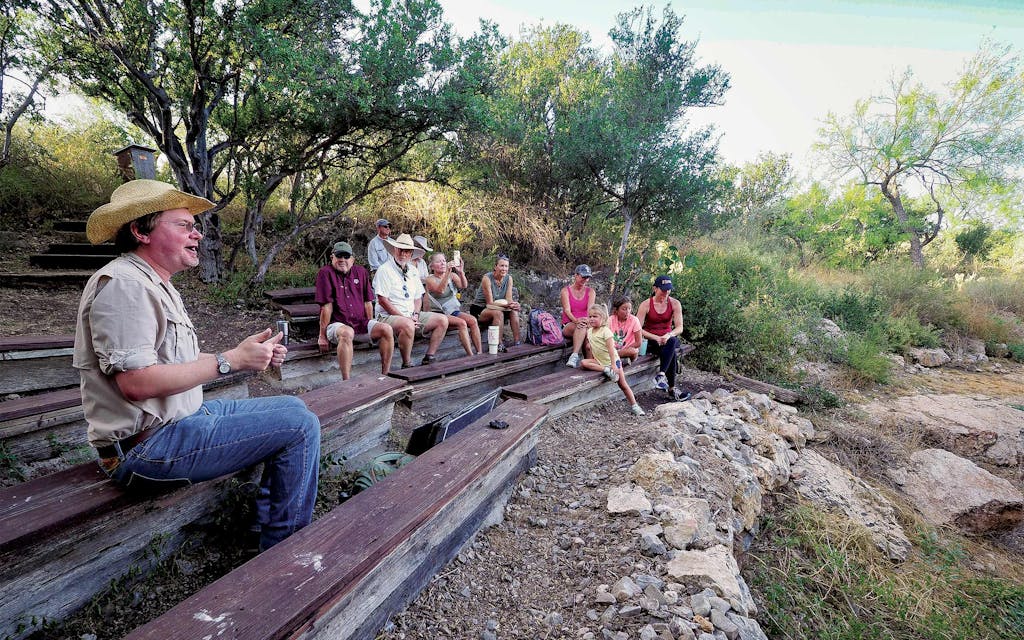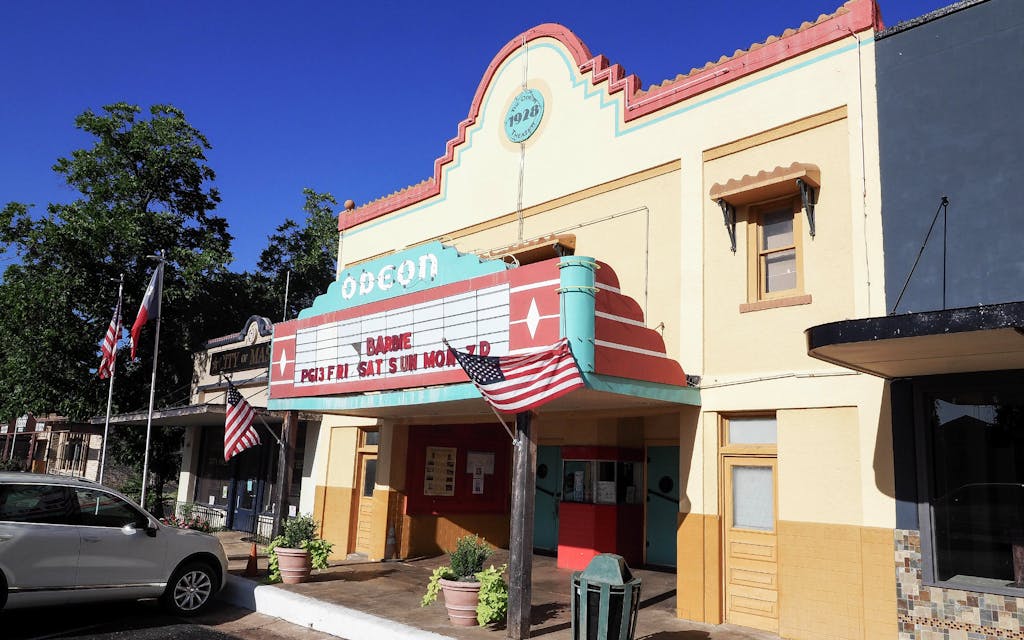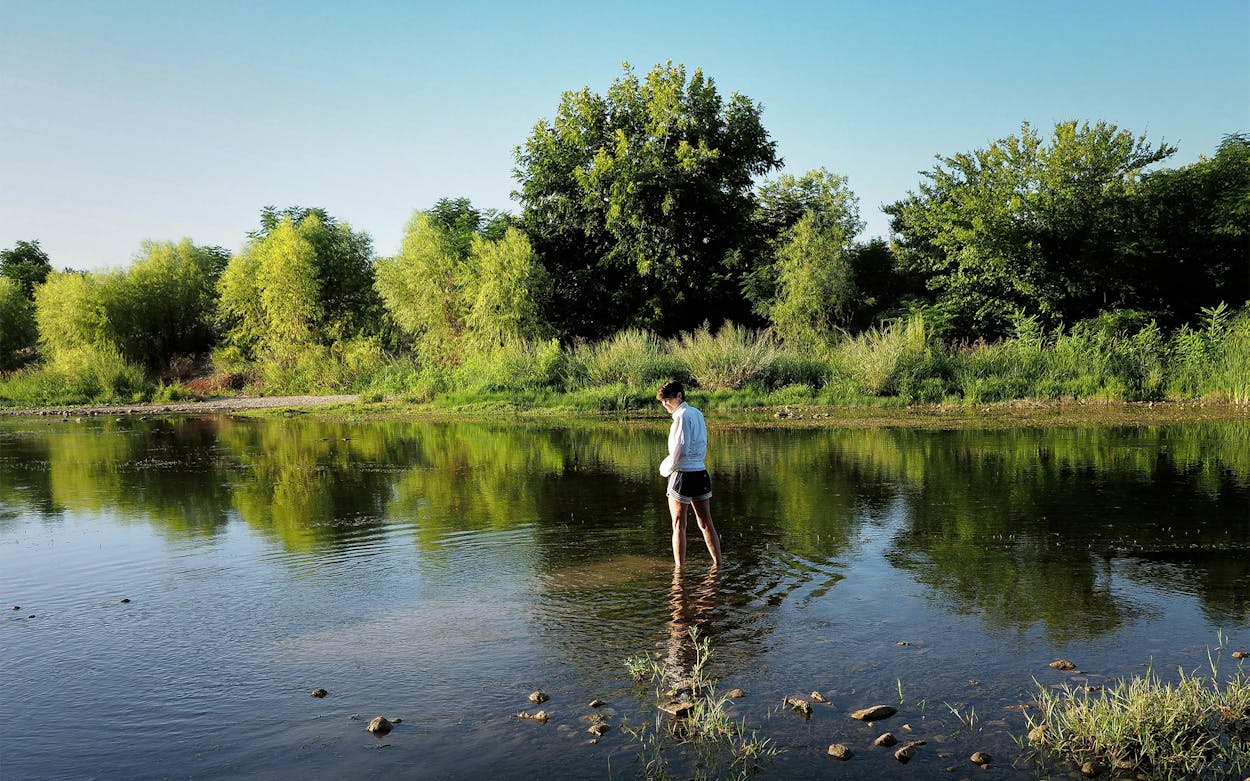Forget Taylor Swift. I’m gearing up for an equally impressive show sixteen miles south of Mason, in the Texas Hill Country, where millions of fig-size mammals are preparing to fly out of a smelly, school bus–size hole in the ground.
As dust settles, the excitement among the dozen or so folks gathered on wooden bleachers is palpable. “The star of the show tonight is the Mexican free-tailed bat,” says Ben Taylor, emcee for the evening and steward of the Eckert James River Bat Cave Preserve, an eight-acre property managed by the Nature Conservancy of Texas. The bat preserve is a half hour’s drive southwest of Mason, a quiet community with about 2,100 residents, located halfway between the succinctly named hamlets of Grit and Art.
Taylor prepares us for the show by sharing a litany of impressive bat facts. This maternal colony of about four million females, most of which will give birth to a single pup, is roughly four times as populous as the more famous colony that lives underneath the Ann W. Richards Congress Avenue Bridge, in Austin. Up to five hundred bats cram onto every square foot of wall space inside this cave, and each night they stream out in search of insects.
The bats eat a lot—up to two thirds of their body weight in insects—but so do the critters that take advantage of their nightly exodus. Taylor points out two western coachwhip snakes that have slithered into the prickly, brush-covered patch of ground in front of the cave in hopes of snatching a bat or two. (They do.) Overhead, a few hawks have begun to circle. “We’ve got a scout coming out, checking the weather,” Taylor says when the first flapping fig zooms past. Ten minutes later, the area in front of the cave has transformed into a whirling runway. So many bats fly past at once that they create a breeze.

The public can attend the bat emergence here Thursday through Sunday evenings each summer, typically from June through early September. This year’s season wraps up September 3. And the show is just one reason to head to Mason. This historic ranching town grew up around Fort Mason, established by the U.S. Army in 1851 and open to visitors today, and has German roots. Today about 2,100 people live in Mason, the eponymous county seat.
“It’s still a very authentic small Texas town that’s in touch with its agricultural and ranching roots,” says Tony Plutino, a former Austin resident who has lived in Mason since 2002 and runs a kayak guiding service here along the Llano River. “It still has one hundred percent of that essence in its soul.”
First order of business during my weekend visit was a spin around the courthouse square. The Mason County courthouse, built of local limestone in 1909, went up in flames in an arson fire on February 4, 2021. Its deep red granite exterior walls and two-story bone-colored columns survived, but the center dome and clock tower burned and the interior was gutted. Insurance disbursements paid for part of the $20 million restoration project. The state legislature allocated $6 million, the Texas Historical Commission chipped in about $4.1 million, and the community donated several million more to cover the tab. More than two years later, reconstruction is nearing completion. Aside from a shiny new-building gleam, most visitors probably won’t notice a difference between the old Classical Revival–style structure and the restored one. In April, a small crowd gathered on lawn chairs and cheered as crews maneuvered a new, 30,000-pound cupola into place.
“They hoisted it up with a crane and it all went shockingly and impressively flawlessly,” Plutino says. “You could overhear people reminiscing about the courthouse and the fire, and all the hallelujahs and amens. There was just so much relief and gratitude.” A grand reopening of the courthouse will take place sometime this fall.

The bats aren’t the only show in Mason. At the historic Odeon Theater, which opened in 1928 and was described at the time by the Mason County News as “the most attractive playhouse in this section of the country,” you can catch a first-run movie for a paltry $4. Classic movies are free on the third Wednesday of each month. The theater also hosts live musical performances and special events. And in 1957, locals gathered for a special premiere of the Disney film version of Old Yeller, written by Mason County resident and author Fred Gipson.
If you’re an Old Yeller fan—and what kid didn’t shed a tear for that sweet old dog?—pop by the M. Beven Eckert Memorial Library, where you can see a statue of the book’s main characters, Travis Coates and his four-legged friend. Look closely and you’ll find a whole slew of critters hidden in the sculpture, including an armadillo, a horned toad, a snake, and, yes, a dung beetle rolling its marble-size load of poop.
The city celebrates Gipson and his famous children’s novel with an annual Old Yeller Day celebration, scheduled for September 30 this year. Butter-colored pups line up for the Old Yeller look-alike contest, and anyone with a four-legged friend can join in the annual dog parade.
During a previous visit, I stayed at the Red Door Bed & Breakfast, owned by former Mason mayor Brent Hinckley and his wife, Monica, and housed in what was once a variety store. From a rocking chair on the front balcony, you can admire the courthouse across the street. I wanted quick access to the bat cave this time, though, so I opted for a small cabin at Dos Rios RV Park and campground on the Llano River, about ten minutes south of town.
The drought has choked the river’s flow down to a trickle, but I waded in what was left of it and dreamed about future days with higher water levels, when anglers will return to fly-fish and paddlers will aim their canoes and kayaks downstream. When the water’s flowing better, book a guided tour from Llano River Region Adventures.
In cooler months, Dos Rios also makes a good home base for exploring the region by bike. I logged a sweaty fifty miles of gravel riding on two-lane gravel and paved roads south of Mason a few years ago, and I saw a few burnt orange Longhorns and some bounding deer as I pedaled. We waded our bikes across the James River crossing, stopped to admire a rocky canyon, and flopped into the river (full that September) to revive our rubbery legs after returning to camp.
Should your tastes run more to indulgence than endurance, you’ll enjoy sampling Mason’s budding wine scene. Area winemakers say Mason County’s sandy soil differs from that in the grape-growing hot spot of Fredericksburg, where soils are more rich in limestone. They’re working to get their own American Viticultural Area designation. Half a dozen wineries now operate tasting rooms downtown. Sandstone Cellars Winery was the first to open here, in 2004, but we picked up a bottle of pinot grigio at Peters Prairie Vineyard, mainly because I liked the roadrunner on the label. Fly Gap Winery, Robert Clay Vineyards, Murphy Creek Cellars, and Parr Vineyards also operate tasting rooms in Mason, and Bill Blackmon of William Chris Vineyards, in Hye, is opening a tasting room this fall.
More into liquor than wine? Water drawn from springs on the Bar None Ranch just south of Mason is used to make both Goodnight Loving Vodka and Nine Banded Whiskey.
Properly fueled up, we headed to the historic Seaquist House, a fancy-looking three-story Victorian mansion decked out in low white railings and located a few blocks north of the square.
The house was built in 1887 by the Reverend Thomas Broad, then purchased by a New York banker named Edward Reynolds. Swedish immigrant Oscar Seaquist became the home’s third owner in 1919.
The structure had stood abandoned for more than a decade when the Seaquist House Foundation purchased it in 2015 and began the long, expensive process of restoration. Public tours are offered the first Saturday of every month and cost $15 per adult. Plan on spending a few hours exploring the home’s 22 rooms, fifteen fireplaces, hand-carved blocks inset on exterior walls, and musicians’ loft tucked above a ballroom on the third floor.
Before heading out to see the bats in the evening, we nibbled snacks brought from home and sipped that bottle of wine at our cabin. Afterward we planned to drop by the James River Icehouse, perched above the river just across the street from Dos Rios, for a nightcap, but the lights clicked off just as we pulled in.
In town, you can also grab a beer at THC Beer Company, a self-described “nano brewery” downtown that serves craft brews. (And no, despite what its initials might suggest, the place doesn’t serve CBD-infused beer—Mason’s only brewery is named for the initials of the Texas Hill Country.
The next day we tossed back breakfast tacos and fresh-baked biscuits and sipped coffee on the front porch at Willow Creek Cafe on the square. Lea Lou Co-op, housed in an old hardware store and lumberyard around the corner, serves traditional steaks, chops, and burgers. Locals flock to Santos for chile rellenos, tacos, and gorditas. For barbecue, try the original Cooper’s Pit Bar-B-Q, opened in 1953 by George Cooper.
- More About:
- Wine






